The GTX 480 and GTX 470 are Nvidia's first DirectX 11 graphics cards and at last, now they are widely available. Gainward, one of the leading Nvidia-exclusive partners, obviously means business. Apart from the GTX 480 and GTX 470 reference cards, Gainward is among the first partners to launch a non-reference card dubbed the GTX 470 GOOD. We’ve talket about the GTX 480 here, and today it’s time for the standard GTX 470. This graphics card is currently available in EU at around €320, here.
Gainward GTX 470 comes with reference clocks, meaning the GPU runs at 607MHz, the shaders at 1215MHz and the memory at 837MHz (3348MHz effectively).
GTX 470 and GTX 480 are aimed at high end market, and both belong to Nvidia’s only DX11 supporting Geforce series – GTX 400. These cards compete with AMD’s HD 5800, and come based on the GF100, which is the fastest, largest and hottest GPU from Fermi family.
We expected the GTX 480 to get the full version of the GF100 GPU but Nvidia thought differently and the GF100 ended up with one disabled Streaming Multiprocessor (SM). This means that out of 512 available stream processors (16 SM x 32 cores) or CUDA cores as Nvidia likes to call them, the GTX 480 lacks 32 to reach the full number. Going downstream to the GTX 470, this card has two disabled SMs and 448 stream processors in total. Naturally, this raises questions of what happened to the full version of GF100, but at this point we can only speculate.
The GF100 is a complex chip that’s made of four Graphics Processing Clusters, four Raster Engines, six memory controllers, six ROP clusters and, as we’ve said before, 16 SMs. We’re not sure of exactly which SMs are disabled on the GTX, but we do know that the GTX 470 also comes without one ROP cluster containing 8 ROPs. At the same time, this means that the GTX 470’s memory bus is 320 bit, rather than 384-bit like on the GTX 480, which comes with all available ROP clusters. Each individual ROP cluster is assigned with one 64-bit memory controller.
In order to make the performance difference evident, the usual practice is to lower operating clocks. This is the case with the GTX 470 where the GPU runs at 607MHz, compared to the GTX 480’s 701MHz. Stream processors on the GTX 400 cards run at 1401MHz and 1215MHz for the GTX 480 and GTX 470, respectively.
The memory on the GTX 470 runs at 837MHz (3348MHz effectively). Coupled with the 320-bit memory bus, the card’s bandwidth totals at 133.9 GB/s
Nvidia opted on using GDDR5 memory, but the company did run into some problems with the speed. We see that the memory is clocked lower than on AMD’s high-end cards, but AMD uses 256-bit memory bus. As a result, the HD 5870 scores 153.6 GB/s with GDDR5 memory clocked at 4800MHz, whereas the GTX 480 (384-bit memory bus) is capable of 177.4 GB/s despite featuring memory clocked at 3696MHz.
Gainward’s GTX 470 comes with 1280 MB of GDDR5 memory while the faster, GTX 480 packs 1536MB.
The GF100 is a fast and powerful graphics processor, but cooling it on GTX 400 cards has proven to be quite tricky. Nvidia uses dual-slot cooling on both cards and while it does get the job done, both cards get pretty loud. The GTX 480’s TDP stands at 250W and the GTX 470’s at 215W. Idle consumption for the GTX 480 and 470 is 47W and 33W, respectively.
Gainward prepared a new box design for the new cards. Now when the company is once again Premium Nvidia partner, Gainward didn’t miss out on the chance to emphasize that on the GTX 470’s box.
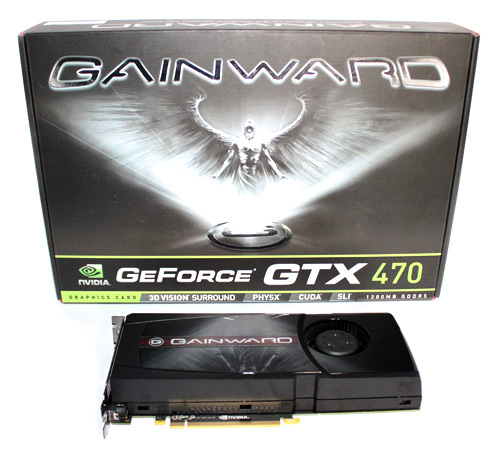
The cable you see on the picture is mini-HDMI-to-HDMI and is 1.5m in length.
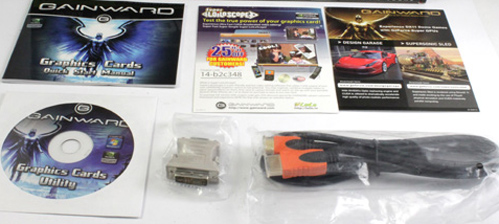
Our today’s GTX 470 comes with reference design. The card features a standard dual slot cooler and comes reference clocked – the GPU runs at 607MHz, shaders at 1401MHz and the memory at 837MHz (3348MHz). Gainward recently announced its GTX 470 GOOD card, which also runs at reference clocks but packs superior cooling which, among other things, usually means more overclocking potential.
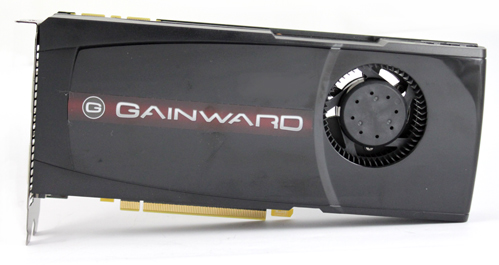
The GTX 470 uses 5 heatpipes for heat transfer, just like the cooler on the GTX 480. The heatpipes are short and managed to fit beneath the plastic hood, so you won’t see them like on the GTX 480. The pictures below show the difference between the GTX 480 and GTX 470.
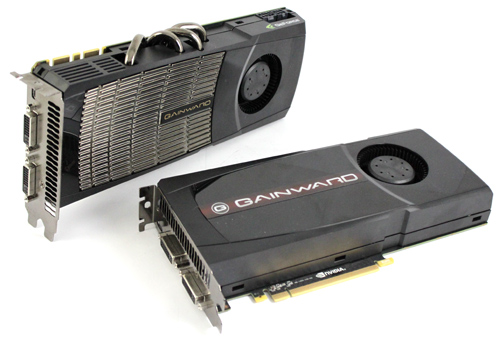
Gainward’s GTX 470 is 241mm long, which means it’s 26mm shorter than the GTX 480 and similar to the HD 5850.
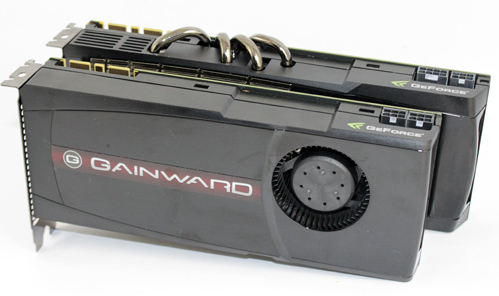
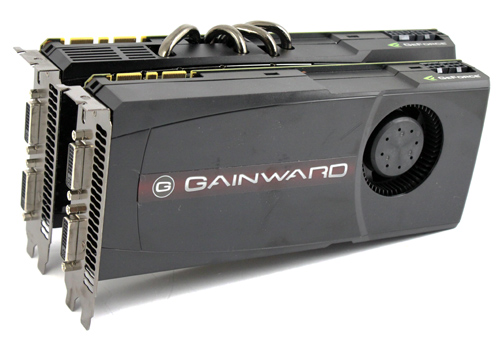
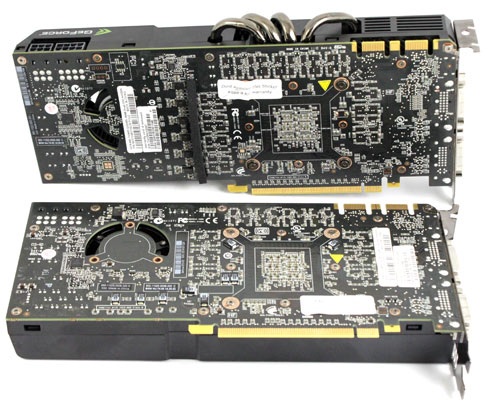
A small 70mm fan is the same one used on the GTX 480. It’s a Delta fan rated at 1.8A. The fan, located at the far end of the graphics card, blows through the aluminum block and hot air leaves the case via the I/O panel’s outlets. In order to provide as much fresh air, the PCB features holes behind the fan. This trick was first done by Nvidia on its dual-GPU GTX 295 cards, and has now found it’s way to the GTX 400 cards.
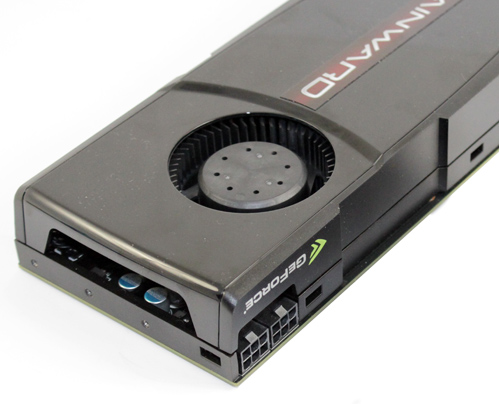
The fan and the plastic hood used to direct air are visible but the plastic hides the large aluminum and metal blocks.
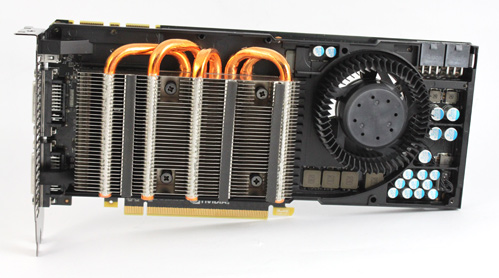
The heatpipes are in direct contact with the GPU.
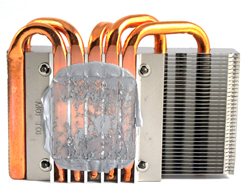
The heatsink with the heatpipes cools the GPU only, while the memory is cooled by the metal block which extends the entire length of the card and cools other hot components.
Nvidia’s Fermi GTX 400 series is in many respects the company’s first. Namely, this is the first time that the green team used GDDR5 memory on their high-end cards. The GTX 470 comes with 10 128MB GDDR5 memory chips (1280MB), whereas the GTX 480 comes with 12 memory chips (1536MB).

On their GTX 480, Nvidia uses 348-bit memory bus with memory clocked at 924MHz (3969MHz effectively), while the GTX 470 uses a 320-bit bus and memory at 837MHz (3348MHz effectively).
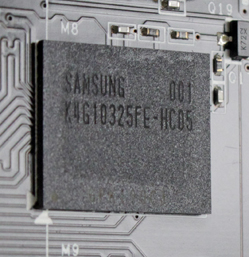
The GTX 470 comes with a 215W TDP and the card requires two 6-pin power connectors. In comparison, the GTX 480’s TDP is 250W and the card needs one 8-pin and one 6-pin connector. Recommended PSU for the GTX 480 is 600W whereas for GTX 470 Nvidia recommends a 550W PSU. Power connectors are located on the top of the card.
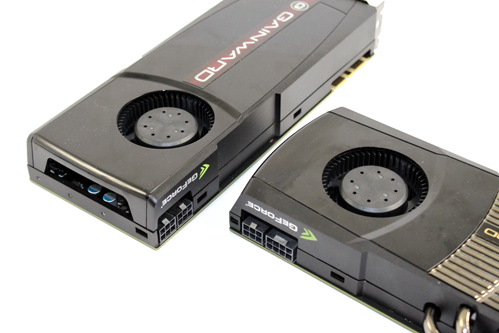
The I/O panel features two standard DVI outs and miniHDMI. We presume Nvidia opted on mini-HDMI to leave more space for ventilation, as the GPU can get pretty hot. The GTX 480 and GTX 470 feature the same I/O panel, as you can see from the picture.
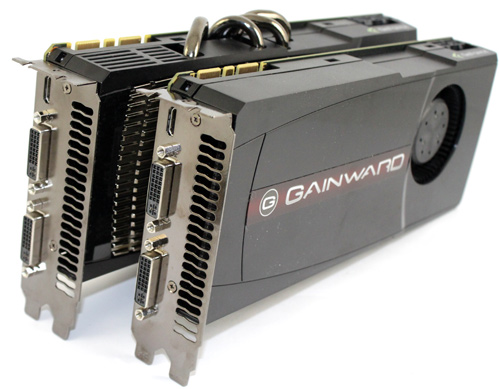
It’s worth noting that the GF100 supports DisplayPort, but Nvidia opted on HDMI as it’s much more common. However, if partners deem it appropriate, they can easily add DisplayPort out on the GTX 400 cards’ I/O panel.
Nvidia included an HDMI sound device within the GPU, which means there’s no need to connect an external audio source to the graphics card when trying to bring both video and audio to your HD device via one cable only. In this respect, the GF100 features the same audio/video capabilities like the 40nm GT200 cards.
Testbed:
Motherboard: EVGA 3xSLI
CPU: Core i7 965 XE (3.6 GHz / 1.270 Volts, Intel EIST and Vdrop enabled)
Memory: 6GB Corsair Dominator 12800 7-7-7-24
Harddisk: OCZ Vertex 2 100 GB
Power Supply: CoolerMaster Ultimate 1100W
Case: Corsair Obsidian 800D
Fan Controler: Kaze Master Pro 5.25"
Operating System: Win7 64-bit
197.41 WHQL
CCC 10.4
Futuremark Vantage
Vantage reports that GTX 480 is currently the fastest single-GPU card and it’s clearly faster than the GTX 470. The GTX 480’s advantage over the HD 5870 melts from 10.5% in Performance to 6.2% in High and ends up at about 3% in Vantage Extreme, but it still manages to beat the HD 5870 in every single test, albeit with a rather tight margin.
In Vantage tests, the GTX 480 constantly beats the GTX 470. Performance test reports 24.7% better results, High settings report 26.6%, whereas Extreme settings result in a 27.2% advantage, naturally in favor of the GTX 480.
Comparing the Gainward GTX 470 to the HD 5870 shows that the latter card packs more punch in more demanding tests. The GTX 470 ends up 12.7% slower in Vantage Performance, 19.3% at High settings and 23.4% at Extreme settings.
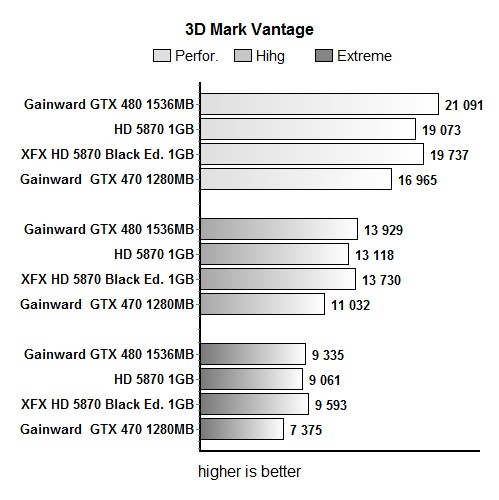
Far Cry2
In FarCry 2, Nvidia’s high-end GTX 400 series comes out on top and it’s even more evident when 8x antialiasing is turned on. FarCry2 results prove that by redesigning ROP subsystems in the GT100 chip, the company managed to improve compression and rendering efficiency as well as rendering smaller primitives that can’t be compressed. Throughput was also much improved compared to GT200 architecture, which resulted in overall better antialiasing performance and significantly smaller drops in performance when switching from 4xAA to 8xAA.
Radeon HD 5870 ends up about 50% slower than the GTX 480 in both tested resolutions with 8xAA. The difference ducks to 39% at 1920x1200 and 4xAA and to 33.6% at 2560x1600, which proves that Nvidia’s GF100 is more efficient with 8xAA. With antialiasing turned off at 2560x1600, the performance difference ends up at only 15.5%.
Gainward’s GTX 470 outpaces the HD 5870 in few occasions, and the highest gap Nvidia’s ace made was at 1920x1200 and 8xAA – 17%. By increasing resolution and turning on antialiasing, the GTX 470 loses the fight versus the HD 5870.
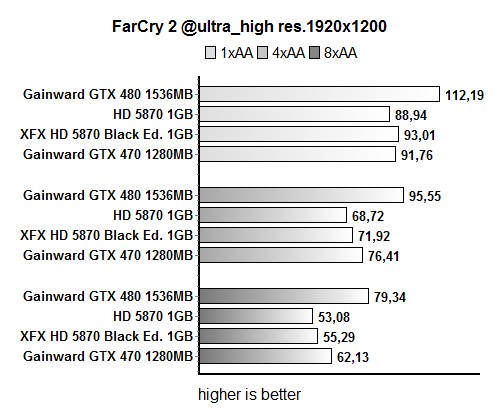

Crysis
Gainward GTX 470 did manage to beat the HD 5870 by up to 17% in FarCry 2, but Crysis is another story. In this game, the HD 5870 beats the GTX 470 by 22-29%. Since the GTX 470 is slower than the GTX 480, and Crysis rates both GTX 480 and HD 5870 almost identically, it was clear that GTX 470 won’t come out on top.
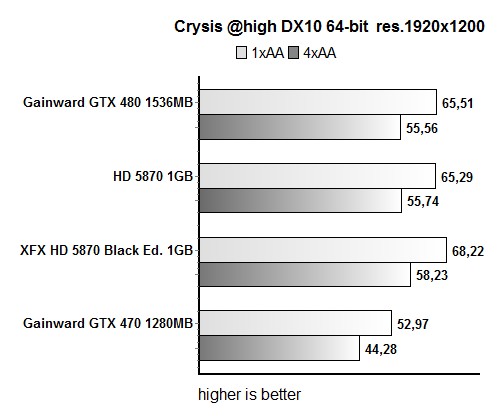
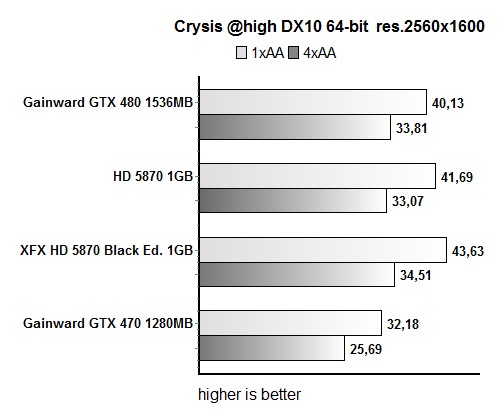
Batman Arkham Asylum
Batman Arkham Asylum is one of the games that features PhysX effects, but if you’re playing it on one of the Radeon cards, you’ll have to turn them off.
Another important thing to note is that switching from 1xAA to 4xAA causes a higher performance hit on the HD 5870 than on the GTX 400 cards. The right answer to the question of “why is that?” has not yet been found, but has turned into a rather hot discussion subject.
“Quote from AMD: In this game, Nvidia has an in-game option for AA, whereas, gamers using ATI Graphics Cards are required to force AA on in the Catalyst Control Center. The advantage of in-game AA is that the engine can run AA selectively on scenes whereas Forced AA in CCC is required to use brute force to apply AA on every scene and object, requiring much more work.”
“Quote from Nvidia: “We are proud of the work we do in The Way It's Meant to be Played. We work hard to deliver kickass, game-changing features in PC games like PhysX, AA, and 3D Vision for games like Batman. If AMD wants to deliver innovation for PC games then we encourage them to roll up their sleeves and do the same. NVIDIA Developer Relations”
Batman results show that AMD doesn’t quite fare great with antialiasing, but it gets better without it.
At 1920x1200 and no antialiasing, the difference is only 4.7%, but the GTX 480 makes it much higher after we turned 4xAA on – it beats the HD 5870 by as much as 45.9%. The difference at 2560x1600 with no antialiasing is once again minimal; only 2.8%. However, after turning on 4xAA, the gap extends to 50%.
At 2560x1600 in Batman Arkham Asylum sees the HD 5870 perform as much as 82.8% slower after applying 4xAA, while the GTX 480 performance drops by 25.3%. The same scenario results in the GTX 470 running 27.5% slower, which is similar to the GTX 480.
Turning on 4xAA antialiasing at 1920x1200 results in the GTX 480 performing 23.1% slower. Performance drops by 26.3% when you turn on the 4xAA antialiasing at 1920x1200 resolution with the GTX 470. On the other hand, the performance of the HD 5870 drops by as much as 71.4% with same settings. These results clearly show that antialiasing causes higher drops in performance on AMD HD 5870 card.
Not much to complain about Radeon HD 5870’s performance in Batman as it scores almost 60fps at 2560x1600 and 4xAA. It’s a pity that PhysX is intended only for Geforce cards.
The GTX 470 ends up slower than the HD 5870 at resolutions with no antialiasing by 16.6% and 20.5%, respectively. Upon turning on 4xAA on, the situation changes in the GTX 470’s favor. It manages a nice comeback and beats the HD 5870 by 16.3% at 1920x1200 and 19% at 2560x1600.


At 1920x1200, the GTX 480’s PhysX capabilities are 26.6% better than the GTX 470’s. At 2560x1600, the GTX 480 outruns its little brother by 22.7%.
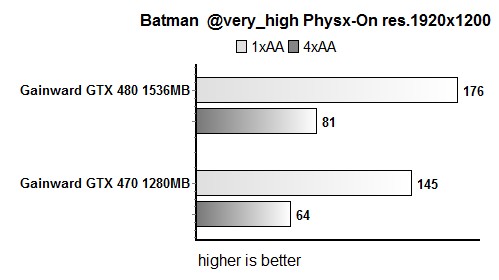
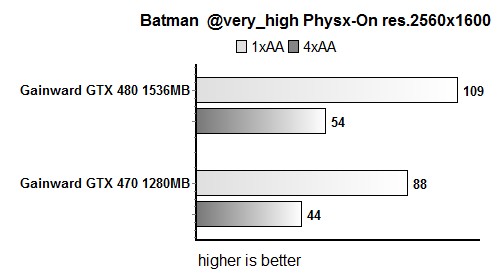
HAWX
You might’ve noticed that playing FarCry2, Batman and Crysis at the highest tested resolution, 2560x1600 (and no AA), results in minimum difference between the HD 5870 and GTX 480, while XFX’s Black Edition ends up as the fastest several times. Gaming with antialiasing isn’t working in HD 5870’s favor as it ends up as much as 50% slower in FarCry2 and Batman. Crysis reported pretty even performance while HAWX manages to put a better face on the Radeon HD 5870.
At 1920x1200 and no AA, Gainward GTX 480 outscores the HD 5870 by 16.7% while turning on 4xAA results in 20.9% advantage. At 2560x1600, Gainward GTX 480 outruns the reference HD 5870 by 4% (no AA) and 12% (4xAA). These results show that antialiasing takes a higher performance toll on HD 5870s than on GTX 480 cards.
After turning on 4xAA at 1920x1200, we noticed that the GTX 480 performs 14.5% slower, whereas the HD 5870 takes an 18.7% hit. Increasing the resolution to 2560x1600 also takes its toll so turning on 4xAA on the GTX 480 results in 17.6% slower GTX 480 and 25.8% slower HD 5870 performance. Just for comparison, turning on antialiasing in FarCry2 at 2560x1600 results in the HD 5870 performing 38.4% slower performance. GTX 480’s performance toll is much lower in FarCry 2 – 19.7%.
The GTX 470 couldn’t defeat the HD 5870 as the latter card handles antialiasing much better than in FarCry2 and Batman. Both aforementioned games tend to prefer the GTX 470 when it comes to antialiasing. In HAWX, the GTX 470 lags behind the HD 5870 by 5.9% and 16.9% at 1900x1200 and 2560x1600, respectively. After turning antialiasing on, the differences duck to 3.4% and 11.9% respectively.
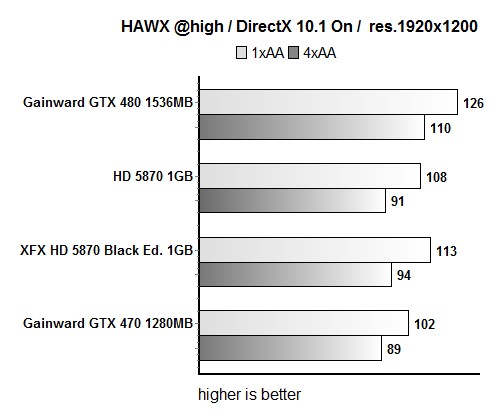
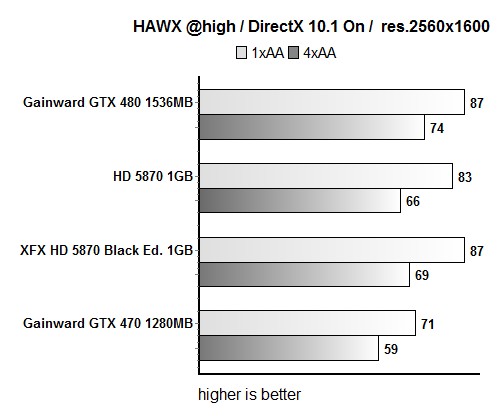
Dirt 2
Dirt 2 is one of the newer games that utilize certain features of DirectX 11. At 1920x1200, the GTX 480 beats the HD 5870 by about 20%. This difference melts to about 7% at 2560x1600, with and without AA.
Gainward GTX 470 fares well versus the HD 5870 at 1920x1200, but as soon as we hit 2560x1600, the HD 5870 proves that it’s faster. At 1920x1200 and 2560x1600 (no AA), the GTX 470 is slower by 2.3% and 15%, respectively. After turning antialiasing on, the difference melts to 3.2% and 16.9%, respectively.
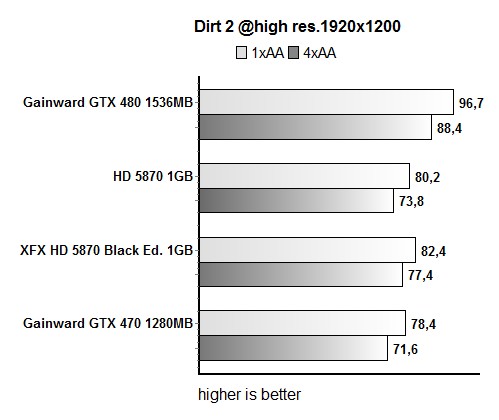
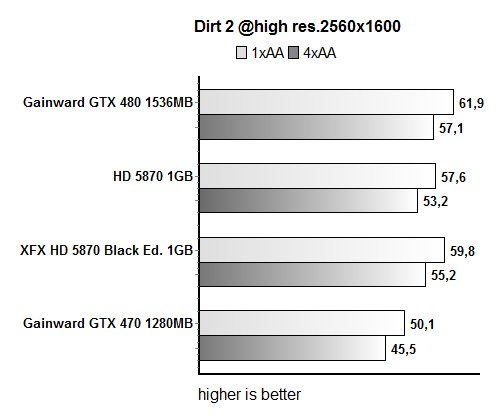
Metro 2033
Metro 2033 is post-apocalyptic game developed by 4A Game and implements a number of advanced DX11 features with the latest generation of DX11 graphics cards. GTX 480 takes the cake in this test, but the differences aren’t very high. At 1680x1050 and 1920x1200, the GTX 480 beats the HD 5870 and GTX 470 by about 18% and 28%, respectively.
At 1920x1200 in Metro 2033, XFX’s HD 5870 Black Edition card ends up faster than the reference HD 5870 by 2.6%, and by 4.7% at 2560x1600.

Unigine Heaven
Nvidia made the GTX 480 with serious tessellation potential in mind, and the results confirm that. The level of tessellation can be regulated in Heaven engine and we see that the difference between the GTX 480 and HD 5870 rises after setting the tessellation level at Extreme. It’s well worth noting that Gainward GTX 480 manages a playable framerate at 1920x1200 with maximum tessellation.
At Extreme tessellation settings, Gainward’s GTX 470 outpaces the HD 5870 by about 27%. The GTX 470 scores 709 on the test while the HD 5870 scores 557.
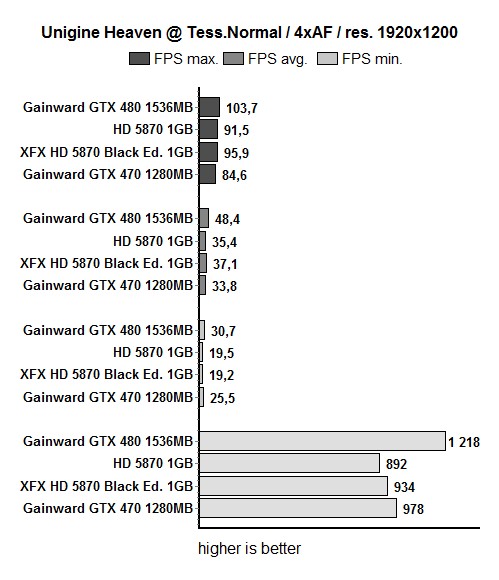
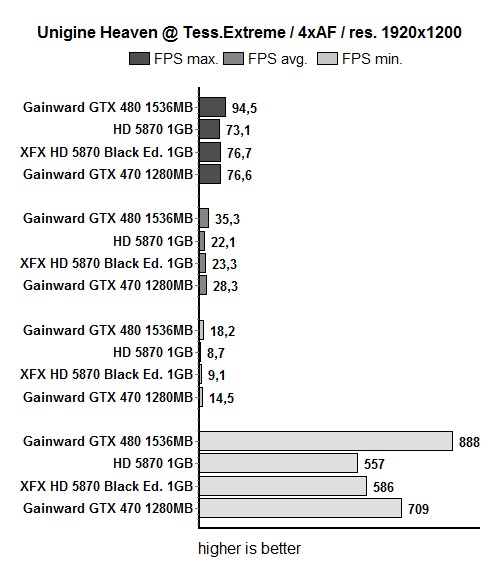
Gainward GTX 470 runs at 607/1215/837 MHz for the GPU/Shaders/Memory – meaning we’re talking about reference clocks. Nvidia strapped the GTX 470 with a dual-slot cooler, but the card easily hits 90° in 3D. The cooler is similar to the one used on the GTX 480, and it uses the same Delta 1.8A fan.
The cooler is capable of keeping temperatures in check, but it does get pretty loud when the GPU heats-up. Still, it’s quieter than the one on the GTX 480. At reference clocks, maximum GPU temperatures didn’t exceed 93°C in FurMark test, and the fan spun at about 3000 RPM. In idle mode, Gainward’s GTX 470 ran pretty quiet.

Overclocking always requires some kind of sacrifice – thermals, noise or both. In this case, we had to push the fan to maximum RPM, which made the fan a bit too loud, but GPU temperatures didn’t exceed 83 °C. We didn’t meddle with voltages but managed to push the GPU from reference 607MHz to 750MHz. Overclocking the memory on GTX 400 cards is a bit tough, and we only managed to reach 890MHz (3560MHz, reference is 837MHz). Overclocking brought up to 19.6% better results in FarCry 2.
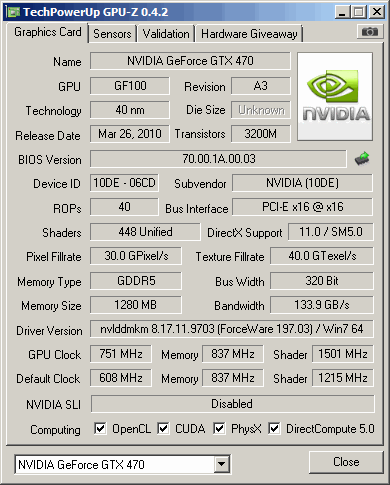
We used Gainward ExperTool to alter the clocks, but this tool is also in charge of fan RPM regulation. Note however that although GPU and shader clocks can be set independently via their respective sliders, overclocking will only run if the shaders run at twice the speed of GPU.
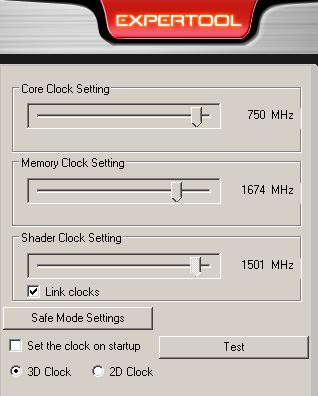
Power Consumption
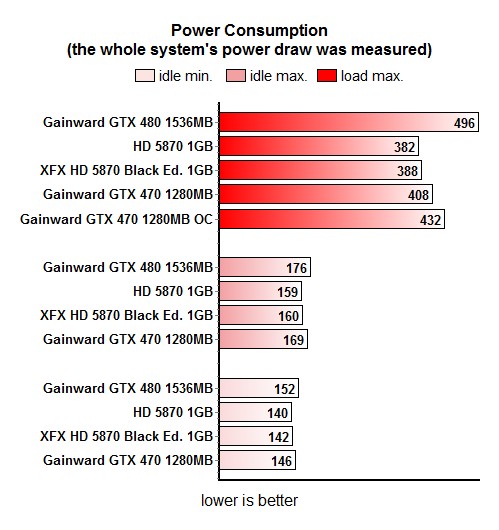
Conclusion
Gainward GTX 470 is a great gaming card, and there are virtually no cons when it comes to performance. The fan, on the other hand, leaves a lot to be desired as the card can get pretty loud when the GPU is under load. Those that find the occasionally high noise levels discouraging can always resort to Gainward’s GTX 470 GOOD card with non-reference cooling and a slightly higher price tag. Standard GTX 470 cards currently go for about €320.
On the other side of the graphics fence, AMD’s HD 5870 is priced some €20 higher, and while our testing does prove it’s slightly faster, the GTX 470 often stages a comeback and wins. Basically it is often all down to particular titles and user preferences. This has been especially true in antialiasing tests, but it does fare well in DirectX 11 performance tests as well. If you like PhysX, CUDA or 3DVision, then GTX 470 might be what you’re looking for, but note that if you’re looking to add more than two monitors to your setup with a single card, you’ll have to turn to the red camp as Nvidia currently offers no such feature.
Unfortunately, choosing between these two cards is not as straightforward as it used to be. They are very closely matched both in terms of performance and price, so you basically can’t go wrong with either one.
You can find the card here.

